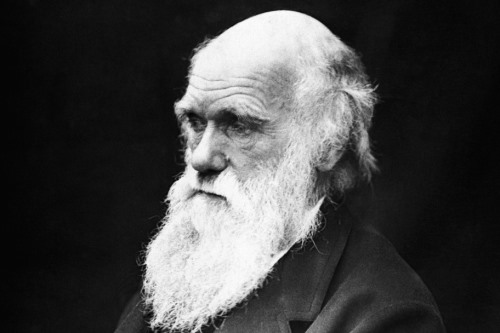Today’s Guest Writer is: Mark A. Korodan
The Origin of Species (OOS) by Charles Robert Darwin (1809-1882) published in 1859, is considered by many in the scientific community to be one of the most important books ever written. The sixth edition (1872) is still regarded as one of the best defenses of gradualism (Darwinian Evolution). Most high school and university textbooks devote considerable space to Darwin and his hypothesis.
Mr. Darwin was an avid naturalist, and as such, he could not accept the idea of a supernatural creation. His observations of nature from his youth, and especially during his time on the HMS Beagle, led him to formulate the hypothesis of evolution.
Darwin suggested that populations contain many variants (different looking individuals of the same species) and that some variants are more successful in reproducing than others. In addition, competition for limited resources and changing environmental conditions, results with one variant causing the extinction of the other(s). Darwin called this process Natural Selection (NS). Nature selects the most fit variant (in terms of reproduction) to increase in a population and the less fit variant (with lower reproduction rates) to eventually become extinct. This hypothesis suggests that natural selection acts only by taking advantage of slight successive variations, hence the term “gradualism.” The process takes an extremely long period of time and requires the assumption of a very old earth. A very long period of time is absolutely crucial to this hypothesis.

When looking into the question of origins and diversity of life there are only two alternatives: life is either a creation of God or the result of natural, organic processes. One who rejects the former must resort to the latter, not because of adequate evidence, but as one’s only alternative. The idea of the supernatural creation of individual species was not tenable to Darwin, although he did believe the “Creator breathed life into a few forms or one” to start the process. Darwin did not believe in spontaneous generation as most evolutionists believe today. Darwin accepted the results of Louis Pasteur’s research disproving spontaneous generation. Most of his adult life was spent in an attempt to find some evidence for evolution and disprove the Genesis narrative. Darwin circled the globe gathering evidence he believed would support his hypothesis. He believed most, if not all the evidence gathered supported his hypothesis, save the fossil record. As he laments in his book, the fossil record with its total lack of transitional forms was an enigma to him.

There are three basic assumptions to the hypothesis of evolution: first, there is variability in the phenotype (what the organism looks like) of all populations (species) which is assumed to be caused by the conditions of life such as climate, habitat, and intraspecific competition; secondly, population growth to such an extent that resources become limited, causing increased competition within a species and finally, as a consequence of the above, NS entailing divergence of character (change in what individual variants look like) ultimately causing the extinction of less “improved” (adapted/evolved) forms. Darwin, like most evolutionists, believed evolution to be unidirectional, always resulting in higher, more complex forms. An analysis of each assumption will help to evaluate the plausibility of the hypothesis.
There is one important thing that needs to be understood before a discussion about variability within a population (species) can begin. Charles Darwin and his contemporaries knew nothing about the science of genetics or the laws of inheritance. Therefore all references in OOS to varieties refer to the phenotype, what the organism looks like, and not the genotype i.e. the genetic makeup of the individual. This is important because many populations that exhibit tremendous variability, the genus Canis (dogs) for example, have remained relatively stable for thousands of years. Although the various varieties in this genus may appear (phenotype) very different, their genotype (genetic makeup) allows most “species” in this genus to interbreed and produce fertile young. Mr. Darwin was mistaken when he stated “variation within a population is the fuel for speciation”. No matter how many times Canids, such as the domestic dog, gray wolf, coyote, dingo, pampas fox, golden jackal, or Ethiopian wolf (and others) are crossbred, the resulting progeny are fertile and therefore still dogs.
How NS works is a little different than what Darwin proposed. NS acts on genetically defective individuals (genomes) by preventing successful reproduction, causing the extinction of the defective variety. The DNA provided by the parents in sexually reproducing organisms must be perfect, or able to be “self-repaired.” Any DNA mutation that offspring inherit from their parents is harmful 99.99% of the time. Even the slightest mutation in a DNA sequence, i.e. point mutation, can cause a life- threatening condition. For example, sickle cell anemia and various forms of hemophilia can be caused by a single base-pair substitution, base-pair insertion, or deletion. These very small defects in the genetic code result in coding for the wrong amino acid in critical proteins. When a single wrong amino acid is inserted into a hemoglobin molecule, a chain of 574 amino acids, the result is sickle cell anemia, a structural protein defect. In the case of some forms of hemophilia, a single base-pair substitution results in a faulty clotting factor (functional protein or enzyme) and the blood fails to coagulate. A mutation in the genetic code usually results in disease or death. Living organisms cannot add to or reduce the genetic information received from the parent forms without serious consequences.

Variation, or genetic variance, is the diversity of alleles (a variant of a gene that occurs at a specific location on a chromosome) and genotypes within a population. Think dogs. The plants and animals we observe today were created with an abundance of genetic variance. The genetic variance exhibited in dogs (Canis sp.) is the rule, not the exception. This variability is not the result of mutations, gene flow, sexual reproduction, or any other natural biological process. The evidence for this is the variation and worldwide distribution of the genus Canis sp. (dogs). All the individual species in this genus can interbreed and produce fertile young.
